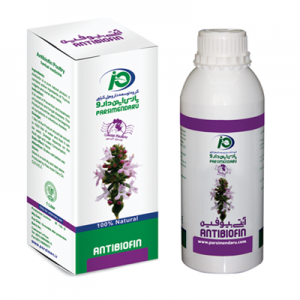Description
(for prevention and treatment of bronchitis in poultry)
Broncofin is a natural-based drug that is made up of active ingredients in eucalyptus, rosemary, thyme and other medicinal herbs. The drug is formulated in such a way that its various components empower and enhance the therapeutic effects of each other by a synergistic activity. The most important components in this drug are: 1, 8-Cineole, Camphene, Fenchone and Terpineole.
MECHANISM OF ACTION: 1, 8-Cineol belongs to class of chemicals called monoterpenoids. The molecule of Cineole can be easily inserted into the cells, and then by the inhibition of the IkBa molecule, it prevents the transfer and function of an important transcription regulator of the cell; NF-KB p65, resulting in interruption of intracellular inflammation pathways. In bronchial epithelial ciliated cells, Cineole acts through blocking the NF-KB pathway and therefore stops the expression of mucin genes which play a key role in the production of mucus polysaccharides, and thus the production of mucus decreases. Cineole reduces the mucus secretion via inhibiting the specific mucus-producing cells (Goblet cells) and thus dampens the total mucus production from the mucosal layers in the bronchus. By reducing the production of mucus, the airways open and breathing becomes more comfortable. In addition, by controlling the NF-K B, the gene expression of inflammatory cytokines such as TNF-a, IL-1B, and IL-6 are also stopped or decreased. The cytokines cause an increase in heat and pain by recruiting the cells producing inflammatory molecules (such as macrophages and neutrophils) into the inflammatory region. Cineole almost immediately halts these reactions and reduces inflammation, heat and pain in the inflammatory area. Moreover, it was known that there are neurons (nerve terminals) within the airways (e.g. nose and bronchi) which are sensible to natural molecules. In this regard, it has been shown that treatment with natural agonists of receptors on neurons, such as Cineole causes a significant reduction in the sense of stimulation in the airways and cessation of cough reflux.
THERAPEUTIC FEATURES: The active ingredients of Broncofin are mucolytic (expectorant), which liquefy the mucosal secretions and facilitate the excretion of the secretions. In addition, it has strong antibacterial and anti-fungal properties and also anti-inflammatory action
INDICATIONS: Broncofin is used to prevent and treat respiratory diseases particularly bronchitis.
TARGET ANIMALS: It can be used in a variety of birds (poultry) including chicken, turkey, quail, partridge, and so on.
INSTRUCTIONS TO USE: Add a part of the drug (between 250-1000 ml) to 1000 liters of
Drinking water and use it for 3-5 days (8 hours a day) under the supervision of a veterinarian.
CONTRAINDICATIONS: Not to be used in conjunction with drinking vaccines.
CLINICAL TRIALS: The results of the clinical trials on Broncofin are as follows:
A.The results of an in-vitro test on Broncofin: The table below provides a comparison of antibiotic susceptibility of Salmonella, Staphylococcus aureus and E.coli which was obtained by the standard disc diffusion method (a disc containing Broncofin). The results were presented as the values indicating the diameter of the inhibition zone for each Bacterium.
Meanwhile, Salmonella and E-coli were resistant to chloramphenicol at the ratios of 24% and 48%, respectively. Also, they were resistant to enrofloxacin at the ratios of 20% and 77%, respectively.
B. In-vivo test results: Day old chicks (n=310) were kept under the standard conditions until the age of 43 days. The chicks in group 1 (NI+NT) was the negative control group (not contaminated with virus). The chicks in other groups were contaminated with the virus particles at the age of 20 days. The first clinical respiratory manifestations were onset at the age of 35 days.
Summary: In summary, the results of the farm experiments indicate that the Broncofin can play a significant role in the treatment of respiratory diseases in poultry; In addition, it has a preventive role in respiratory infections diseases such as bronchitis. As a complementary effect, it can also act as a growth promotion supplement.
This post is also available in: Persian









Reviews
There are no reviews yet.